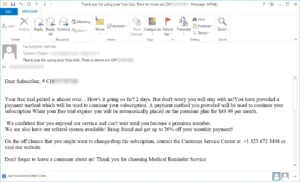Organizations are navigating through an increasingly complex variety of cybersecurity threats. Among these, ransomware attacks have emerged as a significant concern, notably impacting operations and financial stability. With these attacks constituting nearly a quarter (24%) of all data breaches in 2023, the critical importance of adopting vigilant cybersecurity practices has never been more evident.
Phishing emails, a common entry point for such breaches, have prompted businesses to implement sophisticated anti-phishing technologies to protect their IT infrastructure. However, businesses must also be wary of a lesser known but increasingly prevalent threat that targets the security and integrity of business data: callback phishing.
Below, we will explore the basics of callback phishing and provide actionable insights on how to fortify your organization against such attacks. You’ll also learn how working with a managed IT services provider can help you build a solid technological foundation capable of withstanding these risks.
How Callback Phishing Works
Traditionally, phishing scammers initiate contact with users by creating scenarios where they impersonate representatives from trusted institutions, such as banks, government agencies, or service providers. They use messages laced with urgency, fear, and a false sense of authority to prompt immediate action from the recipient. Typically, this manipulation leads the targeted individual to either click on a malicious link, which redirects them to a fraudulent website, or to download an attachment laced with malware, thereby providing the scammers with an entry point into the system.

Original BazarCall callback phishing email
(source: https://www.bleepingcomputer.com/news/security/callback-phishing-attacks-evolve-their-social-engineering-tactics/)
However, callback phishing emails stand out because they contain neither links nor attachments. Instead, these emails typically display the scam’s entire message within a large static image, urging recipients to dial a designated ‘customer service’ phone number. Upon making the call, recipients are connected to scammers who will then attempt to manipulate them into providing device access or divulging account credentials, financial data, or other personal details.
This strategy allows scammers to sidestep anti-phishing filters, which typically scan and analyze text for malicious content and aren’t equipped to decipher an image, call the indicated phone number, or reference a database of malicious phone numbers.
The Dangers of Callback Phishing
The potential consequences of falling victim to a callback phishing scam can be devastating, with numerous ways for hackers to exploit your stolen data.
If the scammer is granted access to your computer and successfully installs ransomware on your device, your organization could face downtime due to disrupted operations, leading to productivity dips and financial loss.
Bad actors may leverage your credentials to initiate fraudulent transactions, unauthorized purchases, or other identity theft scams. Your computer is also a gateway to take control of your infrastructure, locking you out of essential functions and files until you satisfy their demands. For instance, the recent ransomware attack on major American healthcare company Change Healthcare massively disrupted services and may have even led to a costly $22 million payout.
These attacks can also compromise sensitive information, such as client data, confidential business records, and other intellectual property, which may damage your customer trust, reputation, and competitiveness, or result in fines if your industry has strict data protection regulations.
How To Recognize a Callback Phishing Attempt
While we recommend comprehensive end-user awareness training as the best defense for safeguarding your organization from potential callback phishing attempts, here are a few red flags to look out for:
- An email message that comes in a single picture file rather than with standard clickable text and links
- A repeated phone number, especially if prominently displayed
- An unexpected message, especially if purportedly from a sender urging a previously unrequested action
- Urgent language that threatens imminent consequences without immediate action
- An unsolicited request for sensitive information or for making a financial transaction
- Inconsistent branding or a suspicious sender address (misspelled, slightly varies from a real domain, or contains random characters)
- Awkward, generic greetings or unprofessional content, including spelling and grammar errors
Besides knowing what to look for, you can also leverage other tactics for preventing a social engineering attack. For instance, if you receive an email prompting you to call a phone number, always verify the contact information through the organization’s official website or its verified communication channels. It’s also important to understand the recovery process from a ransomware attack, which can significantly reduce potential damage.
More broadly, your organization can benefit from implementing a Zero Trust cybersecurity framework that uses micro-segmentation to prevent lateral movement even if someone breaches your system. Additionally, we recommend implementing robust identity management tactics, such as granular access controls and continuous verification.
How Managed IT Services Protect Against CallBack Phishing and Other Cybersecurity Risks
If they want to avoid these attacks, businesses will need to build a robust IT infrastructure and a security-aware workplace culture. Yet, doing so alone and with limited resources may feel daunting. Partnering with an external managed IT services provider (MSP) allows organizations to offload that work and address their cybersecurity more proactively and comprehensively.
An MSP’s cybersecurity solutions will include conducting regular security assessments to close any protection gaps and focusing on 24/7 monitoring and maintenance. This means that you can preemptively detect and neutralize phishing attacks in real time and rely on continuously optimized system health and performance through software patches, updates, and other techniques, ensuring fewer vulnerabilities to exploit.
As an additional layer of protection, they may also implement best-practice business security strategies and technologies to strengthen your cybersecurity posture, such as DNS filtering, end-point detection and response (EDR) solutions, and backup solutions.
These providers can also provide strategic guidance. They are equipped to deliver your security awareness training and provide more personalized support if needed. They can help you determine what to do if you believe a callback phishing attempt has targeted you. What’s more, their teams stay up-to-date on evolving threats, ensuring they work to protect you from any new variations of callback phishing and other attack methods.
Partner with PC Corp for more resilient IT infrastructure
When your organization’s employees understand how callback phishing scams and other attack methods work, they’ll be able to address cybersecurity more proactively. As a result, you can minimize the risk of data breaches and financial loss while keeping your data secure and accessible.
Partnering with PC Corp for managed IT services, you’ll gain access to expert support designed to keep your systems operating optimally and securely. In addition, we offer end-user security awareness training. Our training program will equip your team with the knowledge to build solid digital hygiene practices and detect and respond to phishing and other social engineering attempts.
Contact PC Corp today to discover how Managed Services can help to improve your overall security posture.

